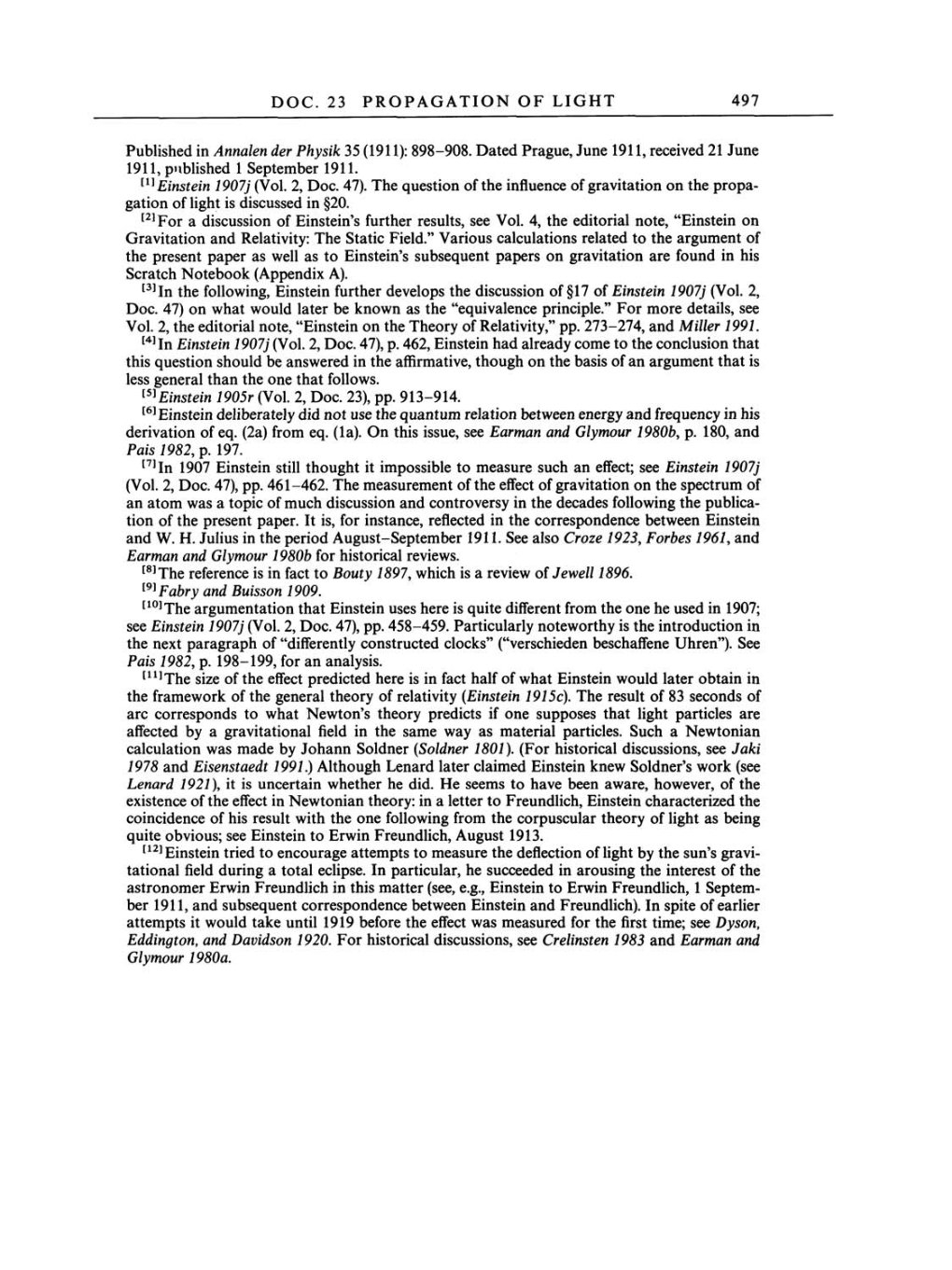DOC.
23
PROPAGATION OF LIGHT
497
Published
in Annalen
der
Physik
35
(1911):
898-908. Dated
Prague,
June
1911,
received
21
June
1911, published
1
September
1911.
[1]Einstein
1907j
(Vol.
2,
Doc.
47).
The
question
of
the
influence of
gravitation
on
the
propa-
gation
of
light
is
discussed
in
§20.
[2]For
a
discussion of Einstein's further
results,
see
Vol.
4,
the editorial
note,
"Einstein
on
Gravitation and
Relativity:
The Static Field." Various calculations related to the
argument
of
the
present paper
as
well
as
to
Einstein's
subsequent papers
on
gravitation
are
found in his
Scratch Notebook
(Appendix
A).
[3]In
the
following,
Einstein further
develops
the discussion of
§17
of Einstein
1907j (Vol.
2,
Doc.
47) on
what would later be known
as
the
"equivalence principle."
For
more
details,
see
Vol.
2,
the editorial
note,
"Einstein
on
the
Theory
of
Relativity,"
pp.
273-274,
and Miller
1991.
[4]In
Einstein
1907j (Vol.
2,
Doc.
47), p. 462,
Einstein
had
already
come
to the conclusion
that
this
question
should
be
answered
in
the
affirmative, though
on
the basis of
an
argument
that
is
less
general
than the
one
that
follows.
[5]Einstein
1905r
(Vol.
2,
Doc.
23),
pp.
913-914.
[6]Einstein
deliberately
did
not
use
the
quantum
relation
between
energy
and
frequency
in
his
derivation of
eq. (2a)
from
eq. (1a).
On
this
issue, see
Earman and
Glymour 1980b, p. 180,
and
Pais
1982,
p.
197.
[7]In 1907
Einstein
still thought
it
impossible
to
measure
such
an effect; see
Einstein
1907j
(Vol.
2,
Doc.
47), pp.
461-462. The
measurement
of the
effect
of
gravitation
on
the
spectrum
of
an
atom
was a
topic
of much discussion and
controversy in
the decades
following
the
publica-
tion of the
present paper.
It
is,
for
instance, reflected
in the
correspondence
between Einstein
and
W. H.
Julius
in
the
period August-September
1911.
See
also
Croze
1923,
Forbes
1961,
and
Earman and
Glymour
1980b
for historical
reviews.
[8]The
reference
is
in
fact
to
Bouty 1897,
which is
a
review
of
Jewell
1896.
[9]Fabry
and
Buisson 1909.
[10]The
argumentation
that Einstein
uses
here
is
quite different
from the
one
he
used in
1907;
see
Einstein
1907j (Vol.
2,
Doc.
47),
pp.
458-459.
Particularly noteworthy is
the introduction in
the
next
paragraph
of
"differently
constructed clocks"
("verschieden
beschaffene
Uhren").
See
Pais
1982, p.
198-199,
for
an
analysis.
[11]The size
of the
effect predicted
here
is
in fact
half of what Einstein
would
later obtain
in
the
framework
of the
general theory
of
relativity
(Einstein 1915c).
The result of
83
seconds of
arc
corresponds
to
what Newton's
theory predicts
if
one supposes
that
light particles are
affected
by
a gravitational
field in
the
same
way as
material
particles.
Such
a
Newtonian
calculation
was
made
by
Johann Soldner
(Soldner 1801).
(For
historical
discussions,
see
Jaki
1978
and Eisenstaedt
1991.)
Although
Lenard later claimed Einstein knew Soldner's work
(see
Lenard
1921),
it
is
uncertain whether
he did.
He
seems
to
have been
aware,
however,
of the
existence of the
effect in
Newtonian
theory:
in
a
letter to
Freundlich,
Einstein characterized the
coincidence of
his
result with
the
one
following
from the
corpuscular theory
of
light
as
being
quite obvious;
see
Einstein
to
Erwin
Freundlich, August
1913.
[12]Einstein
tried
to
encourage attempts
to
measure
the deflection of
light by
the sun's
gravi-
tational
field
during
a
total
eclipse.
In
particular,
he succeeded
in
arousing
the interest of the
astronomer
Erwin Freundlich
in
this
matter
(see, e.g.,
Einstein
to
Erwin
Freundlich,
1
Septem-
ber
1911,
and
subsequent correspondence
between Einstein and
Freundlich).
In
spite
of earlier
attempts
it
would
take until
1919
before the
effect
was
measured
for the
first
time;
see
Dyson,
Eddington,
and
Davidson 1920.
For historical
discussions,
see
Crelinsten
1983
and
Earman
and
Glymour
1980a.
